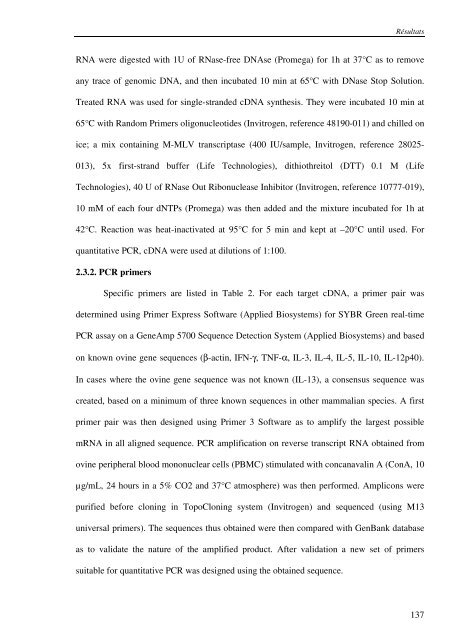Régulation des populations de Nématodes gastro-intestinaux ...
Régulation des populations de Nématodes gastro-intestinaux ...
Régulation des populations de Nématodes gastro-intestinaux ...
Create successful ePaper yourself
Turn your PDF publications into a flip-book with our unique Google optimized e-Paper software.
Résultats<br />
RNA were digested with 1U of RNase-free DNAse (Promega) for 1h at 37°C as to remove<br />
any trace of genomic DNA, and then incubated 10 min at 65°C with DNase Stop Solution.<br />
Treated RNA was used for single-stran<strong>de</strong>d cDNA synthesis. They were incubated 10 min at<br />
65°C with Random Primers oligonucleoti<strong><strong>de</strong>s</strong> (Invitrogen, reference 48190-011) and chilled on<br />
ice; a mix containing M-MLV transcriptase (400 IU/sample, Invitrogen, reference 28025-<br />
013), 5x first-strand buffer (Life Technologies), dithiothreitol (DTT) 0.1 M (Life<br />
Technologies), 40 U of RNase Out Ribonuclease Inhibitor (Invitrogen, reference 10777-019),<br />
10 mM of each four dNTPs (Promega) was then ad<strong>de</strong>d and the mixture incubated for 1h at<br />
42°C. Reaction was heat-inactivated at 95°C for 5 min and kept at –20°C until used. For<br />
quantitative PCR, cDNA were used at dilutions of 1:100.<br />
2.3.2. PCR primers<br />
Specific primers are listed in Table 2. For each target cDNA, a primer pair was<br />
<strong>de</strong>termined using Primer Express Software (Applied Biosystems) for SYBR Green real-time<br />
PCR assay on a GeneAmp 5700 Sequence Detection System (Applied Biosystems) and based<br />
on known ovine gene sequences (β-actin, IFN-γ, TNF-α, IL-3, IL-4, IL-5, IL-10, IL-12p40).<br />
In cases where the ovine gene sequence was not known (IL-13), a consensus sequence was<br />
created, based on a minimum of three known sequences in other mammalian species. A first<br />
primer pair was then <strong><strong>de</strong>s</strong>igned using Primer 3 Software as to amplify the largest possible<br />
mRNA in all aligned sequence. PCR amplification on reverse transcript RNA obtained from<br />
ovine peripheral blood mononuclear cells (PBMC) stimulated with concanavalin A (ConA, 10<br />
µg/mL, 24 hours in a 5% CO2 and 37°C atmosphere) was then performed. Amplicons were<br />
purified before cloning in TopoCloning system (Invitrogen) and sequenced (using M13<br />
universal primers). The sequences thus obtained were then compared with GenBank database<br />
as to validate the nature of the amplified product. After validation a new set of primers<br />
suitable for quantitative PCR was <strong><strong>de</strong>s</strong>igned using the obtained sequence.<br />
137

















